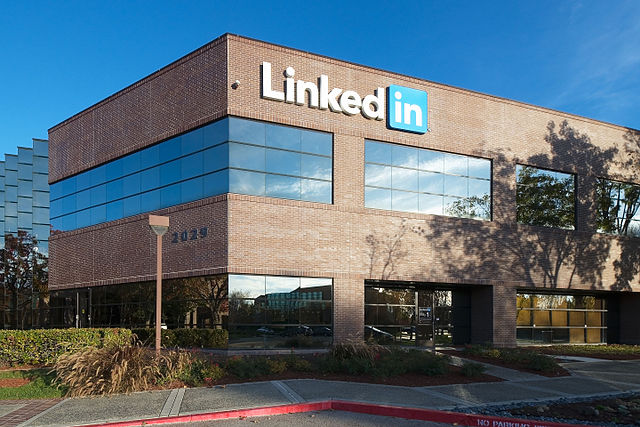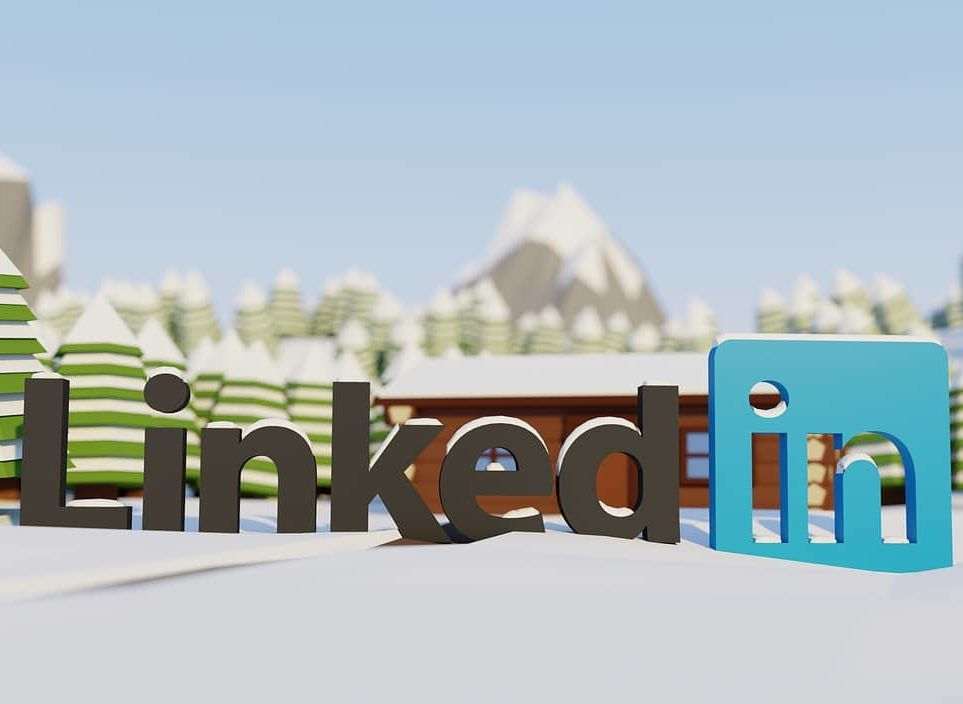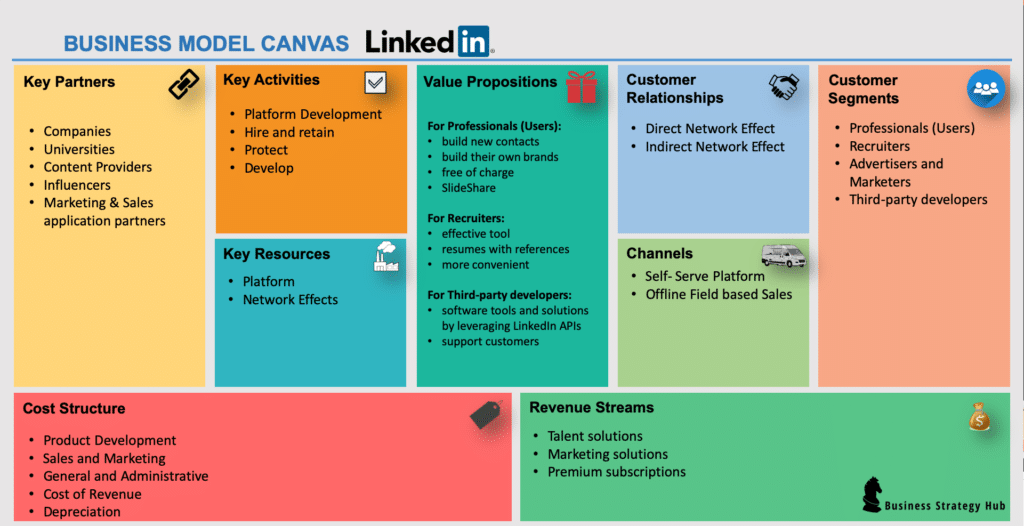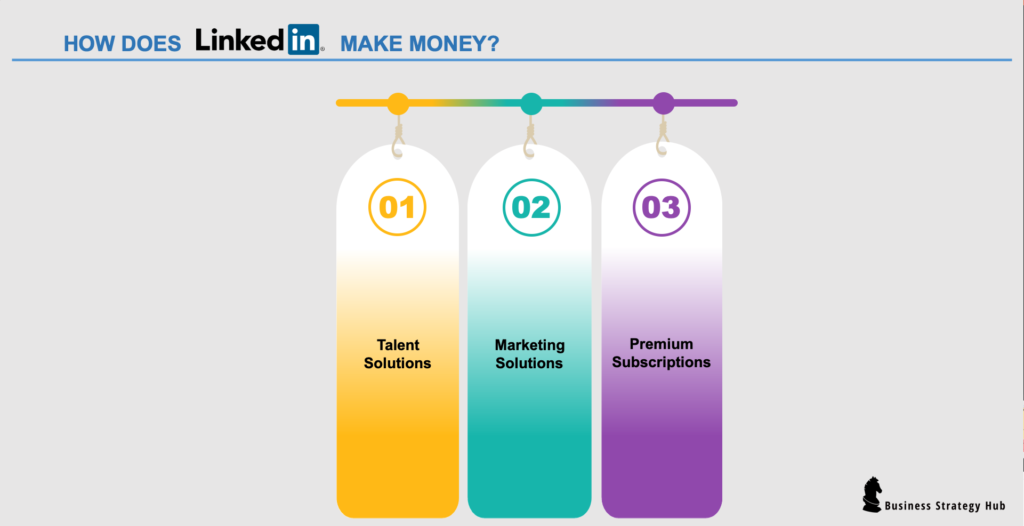Last updated: Out 9, 2021
Company: LinkedIn (a subsidiary of Microsoft Corporation)
CEO: Jeff Weiner
Year founded: 2002
Headquarter: Sunnyvale, California, USA
Number of Employees (Dec 2018): 13,000
Members (2020) : 722 Million
Acquisition cost (Dec 8, 2016): $ 27 Billion
Annual Revenue(June 2020): $ 8.05 Billion
Products & Services: LinkedIn Company Pages | LinkedIn Groups | Marketing & Development Campaigns | LinkedIn Recruiter | LinkedIn Job Slots | LinkedIn Career Pages | LinkedIn Recruitment Ads | LinkedIn Sales Navigator
Competitors: Zip Recruiter | Indeed | Career Builder | Glassdoor | Hired | Jobs2Career | Monster | Dice | Simply Hired
The benefits that a site like LinkedIn has provided to the business world is limitless. Instead of having to go outside for recruitment, business expansion and maintenance of professional network, people can simply log on to its site and enact the same deeds.
As online presence continues to expand among Internet users, so does the necessity of LinkedIn.
As of November 2020, LinkedIn is the 57th biggest website in the world in terms of engagement and ranked 24th in terms of global traffic. LinkedIn user statistics indicate that it increased by over 32 million in 2020 alone from 690 in Q1 to 706 in Q2 and 722 in Q3. The company is projected to attract users more rapidly once the ongoing crisis is over, and companies start rehiring. [1]
Let’s explore the business model canvas of LinkedIn in more detail.

Business Model Canvas of LinkedIn
1. Customers of LinkedIn
LinkedIn operates under four customer segments.
- Professionals (Users) – The first one is comprised of Internet Users who can access its site online and create their own profiles.
- Recruiters – The next ones are the recruiters who are searching for those who show the most potential, promise, and talent.
- Advertisers and Marketers – The next one is the advertisers and marketers who make it their responsibility to reach senior decision makers as well as a wealthier audience.
- Third-party developers – Finally, there is a developer community who is interested in developing and deploying software tools by utilizing LinkedIn APIs.
2. Value Proposition of LinkedIn
LinkedIn has different value propositions for its various customer segments.
- For Professionals (Users):
- It provides them with the opportunity to display their talents, professional skills as well as expertise.
- It enables them to build new contacts and relationships. Users can leverage newly unveiled features like ‘View Page Followers’ to see all their followers, instead of an aggregate number of followers and general demographics. This functionality also allows users to analyze whatever information is publicly available about their followers, which makes it easier to build new relationships. [2]
- Many of its users have utilized its platform to build their own brands and secure new recruitment.
- The best thing about the LinkedIn platform is that its free of charge for the most essential features. No dime needs to be spent. All LinkedIn is really concerned with is ensuring that its user engagement remains consistent. And that the value of its user profiles increases.
- Professionals and colleagues can connect, interact, and collaborate using the ‘My Company’ feature that was unveiled in 2020. It includes a feature that highlights the milestones achieved by each employee in different ongoing projects as well as trending content from coworkers. This feature also provides an informal meeting space for employees of one company to engage outside work and celebrate accomplishments like promotions. It also recommends colleagues with each other to make it easier for professionals to connect with like-minded people in their company. [3]
- SlideShare– It acts as a slide hosting free service where its users can upload their own content to be viewed publicly or privately in PDF, PowerPoint or any other format.
- For Recruiters:
- LinkedIn acts as an effective tool for them to find their respective candidates and evaluate them accordingly. Recruiters can use the ‘Events’ tab, which makes it easier to access the virtual event functionality on LinkedIn. The update separates virtual events on its page to make it more accessible to recruiters seeking to hold small interviews, webinars, and one-on-one meetings with potential candidates. Since it was introduced in May 2020, more than 200,000 Virtual Events have been hosted on LinkedIn and attended by nearly 10 million people. [4]
- Its database has a wealth of information and resumes with references. All these resumes/ CVs are easy to find and structures at a professional level.
- For recruiters, their job has been made more convenient. They no longer have to go out and create candidate lists through word of mouth.
- With a network like LinkedIn in their arsenal, they can have a wider reach in their listing.
- For Advertisers:
- the same data can be used by advertisers to access a targeted audience
- You simply need to locate the senior executives of your companies of choice in order to set up the targeted advertisement.
- It will function without posing much resistance from the executives.
- For Third-party developers
- Finally, developers can create software tools and solutions by leveraging LinkedIn APIs.
- Often times, these software tools are hosted on third party websites to support customers.
3. Customers Relationships of LinkedIn
- Direct Network Effect
- LinkedIn heavily relies on social networks to pursue its customer relationships. The more there are users on these networks the more it wants them to participate in its own.
- Normal users regard this as the same side network which symbolizes the importance of its users more than the site itself.
- All they require is a platform which LinkedIn provides with its own set of rules.
- Indirect Network Effect
- The presence or absence of recruiters and advertisers do not affect the site in any way whatsoever.
- However, recruiters and advertisers are utilized with respect to the site’s cross-side network effects. Even in this case, the users hold more importance than the latter.
4. Channel of LinkedIn
- Self-Serve Platform – LinkedIn’s main channels are its website and mobile apps. This lets people access and engage with the site’s platform.
- Offline Field based Sales – The sales organization directly deals with large and small enterprise customers.
5. Key Activities of LinkedIn
- Platform Development – The key activity of LinkedIn revolves around platform development and adding new features. The number of monthly users is its essential drivers. Naturally, it requires a platform which can increase its user base. One where they remained active and engaged with. It needs to keep increasing that number to prevent its competition from disrupting its market and displacing its momentum. In 2020, LinkedIn introduced several features, including My Company, Virtual Events, and View Page, on the platform to enhance transparency and understanding about connections, followers, and the information shared on the platform. [5]
- Hire and retain talented employees.
- Protect user information and address privacy concerns.
- Develop a strategic partnership with enterprises and universities.
- Conduct business-related research – LinkedIn is an expert on global business trends and exploits its data to deliver meaningful research to help businesses and professionals. For instance, its latest research conducted in August 2020 reveals that 69% of C-level executives believe that navigating the health crisis is the most challenging experience of their career, and 32% have had to make difficult decisions to protect the future of their business and workforce. Professionals can benefit immensely from LinkedIn’s research. [6]
6. Key Resources of LinkedIn
- Platform – LinkedIn’s platform serves as its primary resource. It is what builds the networks and connections that allow users to access its digital landscape.
- Network Effects – Compared to its network effect and its value; the LinkedIn brand, its employees and even the monetization channels are next to nothing.
7. Key Partners of LinkedIn
LinkedIn has managed to cement its partnerships to expand its business. Some of its partners are:
- Companies –LinkedIn provides a company page to all its member companies, which provides a holistic view of a particular company to its employees, for example, information such as who joined the company, previous title, etc. Also, the Human resource department of these companies gets premium access for recruitment, which includes job posting, advanced searches, InMail, Talent Pipeline, and project management features.
- Universities – Similarly, universities get a university page, which provides a common place to access information about prospective students, alumni, student groups, campus news, etc.
- Content Providers – Some of LinkedIn’s key partners include the authors and publishers who provide learning and skill-based development material on its Lynda platform.
- Influencers – LinkedIn with the help of influencers, also acts as a content distribution network. It utilizes the content of experts to connect with more users and ensure that they continue operating on its platform.
- Marketing & Sales application partners – Companies such as Workday, SAP, HubSpot, Oracle, Salesforce, Zoom, Adobe, Microsoft, etc. utilizes LinkedIn APIs to connect their sales and marketing application to the LinkedIn platform.
8. Cost Structure of LinkedIn
LinkedIn’s cost structure is primarily tied with its platform development, maintenance, and expansion.
Product Development – Its product development cost includes:
- Salaries for developers, engineers, and product managers
- Consulting and external agencies cost
Sales and Marketing – It’s sales and marketing cost includes:
- Salaries, commission, stock-based compensation for sales and marketing employees
- Travel and customer acquisition cost
- Branding, marketing, and advertising cost
- Public relationship cost and more
General and Administrative – it’s General, and administration includes:
- Salaries and Stock-based compensation of executives, finance, human resource, legal and other administrative employees.
- Legal and accounting services cost
- Office facilities maintenance cost
- Other overhead costs
Cost of Revenue – its cost of revenue includes:
- Salaries of infrastructure, customer support, and operations team
- web hosting cost
- credit card processing cost
- Content related expense – Author royalty expense
Depreciation – Finally, depreciation cost includes the depreciation of:
- Computer equipment
- Capitalized Software development cost and more
9. Revenue Stream of LinkedIn
According to the annual report, LinkedIn’s revenue increased from about $5.3 Billion in FY2018 to $6.74 Billion in FY2019 and $8.05 Billion in FY2020. [7]
Let’s see how LinkedIn makes money in more detail:
How Does LinkedIn Make Money?
LinkedIn primarily has three sources of revenue or monetized solutions:
- Talent solutions
- Marketing solutions
- Premium subscriptions
Let’s explore each in more detail:
1. Talent Solutions
Hiring
The LinkedIn business model would not be able to function without $2.3 billions of its revenue. This amount is mostly contributed to its Talent Solutions which serves as its most important premium recruiting tool.
Talent solution mostly operates for companies to help them locate their targeted employees and potential partners for their business. Some of the common services offered by Talent Solutions include job posting, career pages, referrals, recruitment media, etc.
Talent Solutions basically acts as the employee poacher of LinkedIn and drives a competitive environment in its domain.
Moreover, LinkedIn is considered internationally authentic, it allows recruiters to trust different brands with less suspicion and make the recruitment process more convenient. This is why LinkedIn has managed to get the best of its competition whether it be in the form of job portals like Monster Jobs or Indeed.
Learning & Development
Lynda.com – Lynda operates as an eLearning platform. It utilizes a subscription-based model that enables its users to learn everything they want through videos whether it be about technology, business, software or creative skills.
Talent Connect – Talent Connect is an event organized by LinkedIn to give professionals with unique business ideas and hiring strategies to share their practices. The event brings together a wide variety of radical, disruptive, and innovative ideas to address the key challenges and shape the trends in the corporate world. Talent Connect 2020 was expected to be held in Boston from October 14 to 16 and focus on talent acquisition, learning and development, and HR practices. [8]
2. Marketing Solutions
LinkedIn is also a social networking site besides being a recruitment platform. It is currently the most sought-after site by marketers who seek to expand upon their marketing campaigns.
Their Marketing Solutions services provide various features which allow companies to create their own respective pages and create sponsored content to advance their marketing prospects. This also includes sponsored InMails, Ads API and text ads.
3. Premium Subscriptions
Mostly catered to users of LinkedIn, Premium subscriptions allow them to access certain features. Some of the more prominent features in the premium subscription are:
- Who’s Viewed Your Profile
- How You Rank
- Direct messages to Recruiter
- InMail messages
- Online video courses
- Salary insight
- Profinder – hire freelancer service
- Sales Navigator – helps sales professionals to find and qualify prospects
The price point for different premium subscription options are:
- Career – $ 29.99/ month
- Business – $ 47.99/ month
- Sales – $ 64.99/ month
- Recruiter Lite – $ 99.95/ month
The features offered under each subscription vary. For Premium Career, subscribers get 3 InMail messages per month, an option to see who viewed their profile, and information on companies that post jobs. They can also access learning material like video tutorials and use Resume Builder to create CVs. For Premium Business, subscribers get 15 InMail messages, advanced search filters, unlimited searches, on-demand learning, and additional company data. Subscribers on the Sales Navigator Pro plan have access to personalized lists of potential clients, 20 InMail messages, exclusive information about competitors, and some features offered under the Premium Business plan. Lastly, Recruiter Lite offers 30 InMail messages, automatic tracking of candidates, view unlimited profiles, tools for talent pool organization, up to eight premium search filters, and the features offered in previous plans like advanced search. [9]
In Conclusion
LinkedIn has become inseparable for the business community especially those who wish to reach the pinnacle of their careers. Its business model has been constructed with excellence and will continue to hold merit for its users in the long run.
All in all, it’s good will always outweigh the bad.
References & more information
- Iqbal, M. (2020, Nov 6). LinkedIn Usage and Revenue Statistics (2020). Business of Apps
- Ahmed, A. (2020, Sept 4). LinkedIn is bringing three new features. Digital Information World
- Southern M. (2020, Sept 2). LinkedIn Adds 3 New Features to Company Pages. Social Engine Journal
- Ajay, D. (2020, Oct 20). What’s New With LinkedIn Pages. LinkedIn Business
- Valaitis, A. (2020, Sep 2). What’s New With LinkedIn Pages: “My Company” Tab, “Events” Tab, and View Page Followers. LinkedIn Business
- Laker, B. (2020, Sep 23). LinkedIn Research Reveals Rise Of Executive Imposter Syndrome. Forbes
- Clement, J. (2020, Sep 2). LinkedIn: annual revenue, 2017-2020. Statista
- Anderson, B. (2020, February 27). Call for Speakers: Share Your Story at Talent Connect 2020. LinkedIn Business
- Molina, G. (2020, Aug 10). LinkedIn Premium Cost and Benefits: Is it Worth it for your Business. Distant Job
Tell us what you think? Did you find this article interesting? Share your thoughts and experiences in the comments section below.














Very helpful. Can’t even begin to explain just how so very.
Awesome information.
Very finely written. No extra words. Just those which needed. Whoever wrote it…many thanks to him.
Thank you, glad you liked the article 🙂
Your article on the LinkedIn business model is informative and well-structured. I appreciate the clear explanation of how LinkedIn generates revenue.